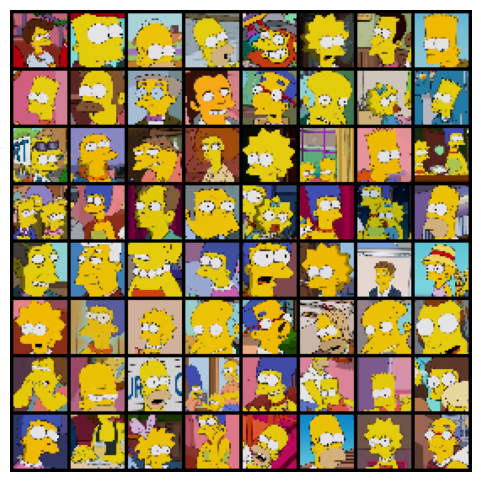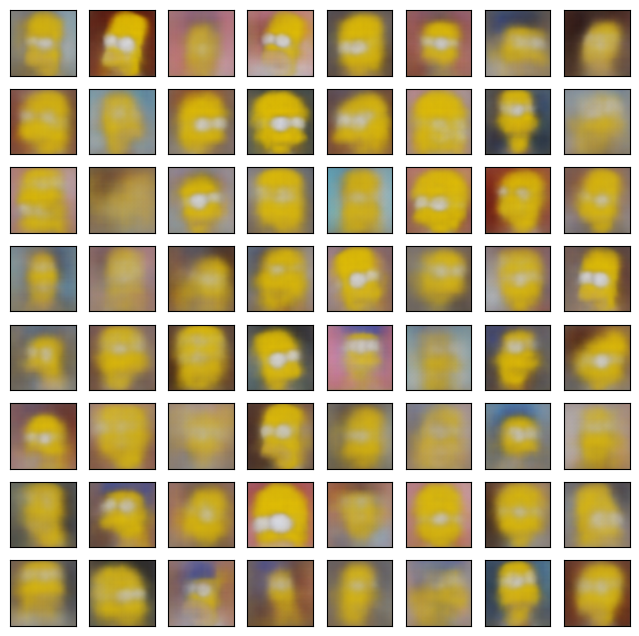Face Generation
A VAE-based Simpsons' faces generation method.
This project was completed by myself.

Variational Autoencoder (VAE)
VAE is a method that combines the advantages of Bayes Method and Deep Learning. VAEs are appealing because they are built on top of standard function approximators (neural networks), and can be trained with stochastic gradient descent. VAEs have already shown promise in generating many kinds of complicated data, including handwritten digits, faces, house numbers, CIFAR images, physical models of scenes, segmentation, and predicting the future from static images.
In this project, VAE is used to generate Simpsons’ faces. Similar to Autoencoder, VAE only show the difference in the latent process. Precisely, VAE will add some noise to the latent, so that the output will be slightly different from the input. However, if the VAE is not well-trained, the images will be blury. This is a drawback of using too much deconvolution that causes the reduction of sharpness.
Model Structure
class VAE(nn.Module):
def __init__(self, zsize):
super(VAE, self).__init__()
self.zsize = zsize
# Encoder
self.conv1 = nn.Conv2d(3, 128, 4, 2, 1) # The kernel size is 4 in order to fit the shape of the image (128*128), each time the width and height will be cut in half.
self.conv1_bn = nn.BatchNorm2d(128)
self.conv2 = nn.Conv2d(128, 256, 4, 2, 1)
self.conv2_bn = nn.BatchNorm2d(256)
self.conv3 = nn.Conv2d(256, 512, 4, 2, 1)
self.conv3_bn = nn.BatchNorm2d(512)
self.conv4 = nn.Conv2d(512, 1024, 4, 2, 1)
self.conv4_bn = nn.BatchNorm2d(1024)
self.conv5 = nn.Conv2d(1024, 2048, 4, 2, 1)
self.conv5_bn = nn.BatchNorm2d(2048)
self.fc1 = nn.Linear(2048 * 4 * 4, zsize) # Fully Connected Layer
self.fc2 = nn.Linear(2048 * 4 * 4, zsize)
# Decoder
self.d1 = nn.Linear(zsize, 2048 * 4 * 4)
self.deconv1 = nn.ConvTranspose2d(2048, 1024, 4, 2, 1)
self.deconv1_bn = nn.BatchNorm2d(1024)
self.deconv2 = nn.ConvTranspose2d(1024, 512, 4, 2, 1)
self.deconv2_bn = nn.BatchNorm2d(512)
self.deconv3 = nn.ConvTranspose2d(512, 256, 4, 2, 1)
self.deconv3_bn = nn.BatchNorm2d(256)
self.deconv4 = nn.ConvTranspose2d(256, 128, 4, 2, 1)
self.deconv4_bn = nn.BatchNorm2d(128)
self.deconv5 = nn.ConvTranspose2d(128, 3, 4, 2, 1)
def encode(self, x):
x = F.relu(self.conv1_bn(self.conv1(x)))
x = F.relu(self.conv2_bn(self.conv2(x)))
x = F.relu(self.conv3_bn(self.conv3(x)))
x = F.relu(self.conv4_bn(self.conv4(x)))
x = F.relu(self.conv5_bn(self.conv5(x)))
x = x.view(x.shape[0], 2048 * 4 * 4)
h1 = self.fc1(x)
h2 = self.fc2(x)
return h1, h2
def reparameterize(self, mu, logvar):
if self.training:
std = torch.exp(0.5 * logvar)
eps = torch.randn_like(std)
return eps.mul(std).add_(mu)
else:
return mu
def decode(self, x):
x = x.view(x.shape[0], self.zsize)
x = self.d1(x)
x = x.view(x.shape[0], 2048, 4, 4)
x = F.leaky_relu(x, 0.2)
x = F.leaky_relu(self.deconv1_bn(self.deconv1(x)), 0.2)
x = F.leaky_relu(self.deconv2_bn(self.deconv2(x)), 0.2)
x = F.leaky_relu(self.deconv3_bn(self.deconv3(x)), 0.2)
x = F.leaky_relu(self.deconv4_bn(self.deconv4(x)), 0.2)
x = torch.tanh(self.deconv5(x))
return x
def forward(self, x):
mu, logvar = self.encode(x)
mu = mu.squeeze()
logvar = logvar.squeeze()
z = self.reparameterize(mu, logvar)
return self.decode(z.view(-1, self.zsize, 1, 1)), mu, logvar
def weight_init(self, mean, std):
for m in self.modules():
if isinstance(m, nn.ConvTranspose2d) or isinstance(m, nn.Conv2d):
m.weight.data.normal_(mean, std)
m.bias.data.zero_()
Result
Final results of faces generated are shown as below:

Interestingly, the results are all seemed blurry. That is caused by the convoluntion process in the decoder, which will blur the edges of images.
For more information, see the work in my github repository!